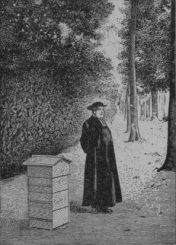
Warré plans
Warré methods
Warré modifications
Warré precursors
Groups / Fora
Google
e-group
Biobees.com
forum
Abbé Warré's book
Beekeeping for All:
T. M. Howatson's 'sparred storey-skape'

T. M. Howatson published his book The Aparian's Manual -- Containing All That Is Important in The Natural History of Bees in 1827 (Edinburgh: Black & Tait) (1). In it he described the construction and use of his hive which he called a 'sparred storey-scape'. This name can be translated as follows: 'sparred' refers to the fact that it has spars, i.e. top-bars; 'storey' means that it is storified or tiered and 'skape' could be a mutation of 'skep', the traditional hive of that time. So we could translate Howatson's hive name as 'top-bar storified skep', or in a more modern way 'storified top-bar hive'.
The boxes -- two in the basic hive -- are of 20 mm thick pine, 12 x 9 inches (303 x 229 mm) long/wide by 8 inches (203 mm) deep. The full depth is therefore 16 inches. The bars are 1 inch (25.4 mm) wide with spacing of half an inch (12.5 mm) except adjacent to the walls where the spacing is a quarter of an inch (6 mm). The 8 bars sit in a rebate ('check') in the long side of the boxes. The basic hive body box is thus very similar to that of a Warré hive (2) only reduced to three quarters in one of the horizontal dimensions. Even the alighting board resembles that of The People's Hive (2).
The hive is extended, 'eked' as Howatson calls it (not 'nadired'), by adding boxes below. To harvest the top box 'the combs being generally fixed to the spars below' he used a knife, wire or stout thread after smoking the bees down. Therefore, in its method of extension and harvesting it is very similar to a Warré hive.
It differs somewhat in the top-of-hive configuration though. Between the top-bars of the top box are strips of glass which fill the gap. This provides a limited possibility for observation of the state of the colony. The roof is a simple box roof which fits over the top box.
In order to get comb for sale as cut comb, Howatson supers with half depth boxes (see dotted line in illustration above) after removing the glass spars from the top brood box. Each box has an entrance notch cut in it but normally only the lowest is open.
Howatson describes how he drives the bees from an occupied 'skape' to an empty one. The two are placed on a table with entrances facing each other. A square section tube comprising glass on top and tin (probably tinned steel sheeting) on the other three sides joins the entrances. A smoke hood (shallow box) is placed on top of the populated hive and the bees smoked out of it into the empty hive.
To catch the queen, two operators are needed. One operates the smoker and the other watches through the glass top of the tube until she emerges. She is then trapped in the tube by the use of suitable shutters.
References
1) Howatson, T. M. The Aparian's Manual -- Containing All That Is Important in The Natural History of Bees in 1827 (Edinburgh: Black & Tait). Download the 6.5 Mb PDF at http://books.google.com/books?id=93VlAAAAMAAJ&hl=en
2) Émile Warré, Beekeeping For All, 2010, trans. from L'Apiculture Pour Tous, (12th ed. 1948) Northern Bee Books. PDF available (see link on left) . (In this book Warré incorrectly writes Philippe du Couédic's name as C. Decouédic.)